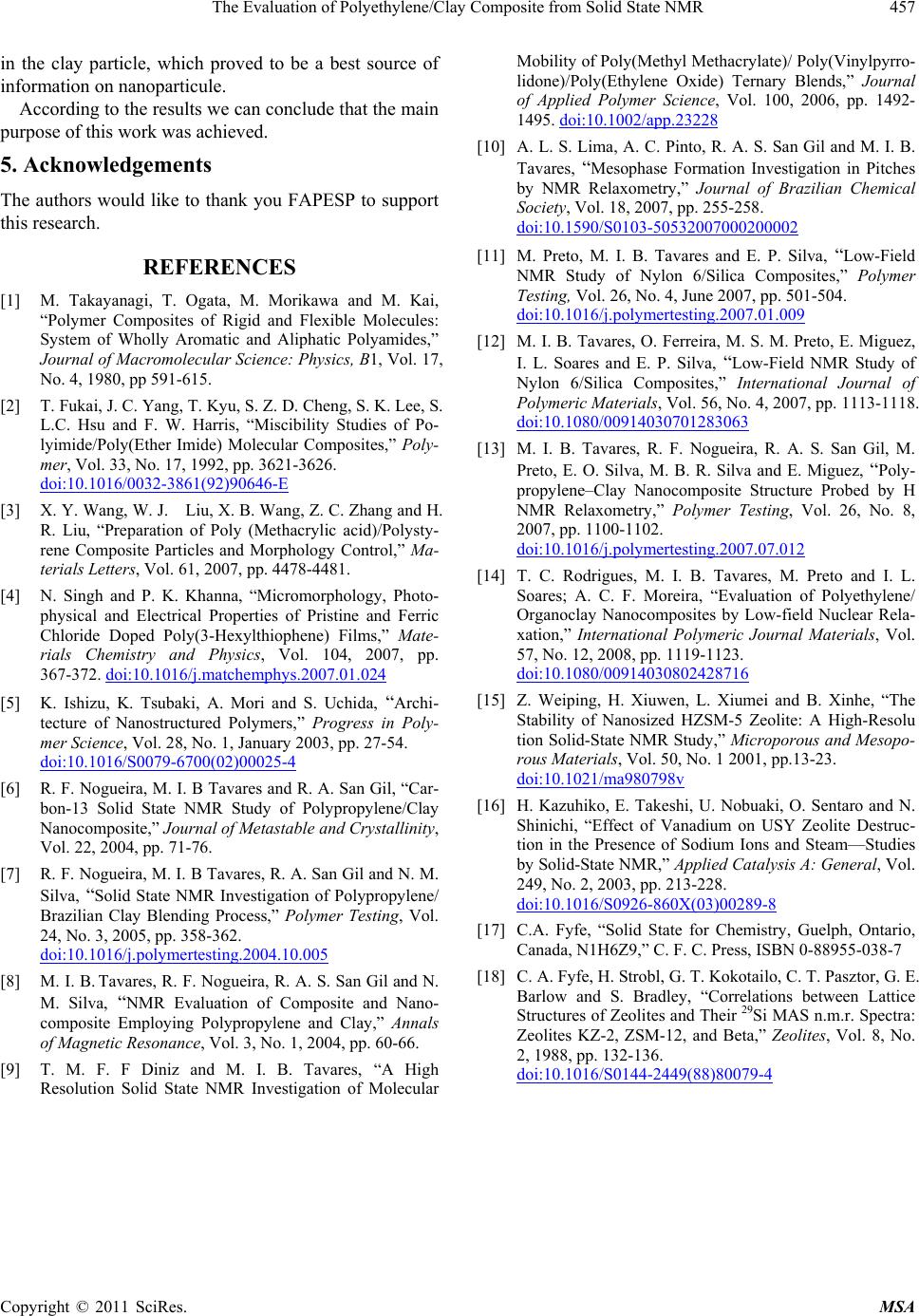
The Evaluation of Polyethylene/Clay Composite from Solid State NMR
Copyright © 2011 SciRes. MSA
in the clay particle, which proved to be a best source of
information on nanoparticule.
According to the results we can conclude that the main
purpose of this work was achieved.
5. Acknowledgements
The authors would like to thank you FAPESP to support
this research.
REFERENCES
[1] M. Takayanagi, T. Ogata, M. Morikawa and M. Kai,
“Polymer Composites of Rigid and Flexible Molecules:
System of Wholly Aromatic and Aliphatic Polyamides,”
Journal of Macromolecular Science: Physics, B1, Vol. 17,
No. 4, 1980, pp 591-615.
[2] T. Fukai, J. C. Yang, T. Ky u, S. Z. D. Cheng, S. K. Lee, S.
L.C. Hsu and F. W. Harris, “Miscibility Studies of Po-
lyimide/Poly(Ether Imide) Molecular Composites,” Poly-
mer, Vol. 33, No. 17, 1992, pp. 3621-3626.
doi:10.1016/0032-3861(92)90646-E
[3] X. Y. Wang, W. J. Liu, X. B. Wang, Z. C. Zhang and H.
R. Liu, “Preparation of Poly (Methacrylic acid)/Polysty-
rene Composite Particles and Morphology Control,” Ma-
terials Letters, Vol. 61, 2007, pp. 4478-4481.
[4] N. Singh and P. K. Khanna, “Micromorphology, Photo-
physical and Electrical Properties of Pristine and Ferric
Chloride Doped Poly(3-Hexylthiophene) Films,” Mate-
rials Chemistry and Physics, Vol. 104, 2007, pp.
367-372. doi:10.1016/j.matchemphys.2007.01.024
[5] K. Ishizu, K. Tsubaki, A. Mori and S. Uchida, “Archi-
tecture of Nanostructured Polymers,” Progress in Poly-
mer Science, Vol. 28, No. 1, January 2003, pp. 27-54.
doi:10.1016/S0079-6700(02)00025-4
[6] R. F. Nogueira, M. I. B Tavares and R. A. San Gil, “Car-
bon-13 Solid State NMR Study of Polypropylene/Clay
Nanocomposite,” Journal of Metastable and Crystallinity,
Vol. 22, 2004, pp. 71-76.
[7] R. F. Nogueira, M. I. B Tavares, R. A. San Gil and N. M.
Silva, “Solid State NMR Investigation of Polypropylene/
Brazilian Clay Blending Process,” Polymer Testing, Vol.
24, No. 3, 2005, pp. 358-362.
doi:10.1016/j.polymertesting.2004.10.005
[8] M. I. B. Tavares, R. F. Nogueira, R. A. S. San Gil and N.
M. Silva, “NMR Evaluation of Composite and Nano-
composite Employing Polypropylene and Clay,” Annals
of Magnetic Resonance, Vol. 3, No. 1, 2004, pp. 60-66.
[9] T. M. F. F Diniz and M. I. B. Tavares, “A High
Resolution Solid State NMR Investigation of Mol ecular
Mobility of Poly(Methy l Methacry late)/ Poly(Vinylpyrro-
lidone)/Poly(Ethylene Oxide) Ternary Blends,” Journal
of Applied Polymer Science, Vol. 100, 2006, pp. 1492-
1495. doi:10.1002/app.23228
[10] A. L. S. Lima, A. C. Pint o, R. A. S. San Gil and M. I. B.
Tavares, “Mesophase Formation Investigation in Pitches
by NMR Relaxometry,” Journal of Brazilian Chemical
Society, Vol. 18, 2007, pp. 255-258.
doi:10.1590/S0103-50532007000200002
[11] M. Preto, M. I. B. Tavares and E. P. Silva, “Low-Field
NMR Study of Nylon 6/Silica Composites,” Polymer
Testing, Vol. 26, No. 4, June 2007, pp. 501-504.
doi:10.1016/j.polymertesting.2007.01.009
[12] M. I. B. Tavares, O. Ferreira, M. S. M. Preto, E. Miguez,
I. L. Soares and E. P. Silva, “Low-Field NMR Study of
Nylon 6/Silica Composites,” International Journal of
Polymeric Materials, Vol. 56, No. 4, 2007, pp. 1113-1118.
doi:10.1080/00914030701283063
[13] M. I. B. Tavares, R. F. Nogueira, R. A. S. San Gil, M.
Preto, E. O. Silva, M. B. R. Silva and E. Migue z, “Poly-
propylene–Clay Nanocomposite Structure Probed by H
NMR Relaxometry,” Polymer Testing, Vol. 26, No. 8,
2007, pp. 1100-1102.
doi:10.1016/j.polymertesting.2007.07.012
[14] T. C. Rodrigues, M. I. B. Tavares, M. Preto and I. L.
Soares; A. C. F. Moreira, “Evaluation of Polyethylene/
Organoclay Nanocomposites by Low-field Nuclear Rela-
xation,” International Polymeric Journal Materials, Vol.
57, No. 12, 2008, pp. 1119-1123.
doi:10.1080/00914030802428716
[15] Z. Weiping, H. Xiuwen, L. Xiumei and B. Xinhe, “The
Stability of Nanosized HZSM-5 Zeolite: A High-Resolu
tion Solid-State NMR Study,” Microporous and Mesopo-
rous Materials, Vol. 50, No. 1 2001, pp.13-23.
doi:10.1021/ma980798v
[16] H. Kazuhiko, E. Takeshi, U. Nobuaki, O. Sentaro and N.
Shinichi, “Effect of Vanadium on USY Zeolite Destruc-
tion in the Presence of Sodium Ions and Steam—Studies
by Solid-State NMR,” Applied Catalysis A: General, Vol.
249, No. 2, 2003, pp. 213-228.
doi:10.1016/S0926-860X(03)00289-8
[17] C.A. Fyfe, “Solid State for Chemistry, Guelph, Ontario,
Canada, N1H6Z9,” C. F. C. Press, ISB N 0-88955-038-7
[18] C. A. Fyfe, H. Strobl , G. T. Kokot a il o, C. T. Pasz tor, G. E.
Barlow and S. Bradley, “Correlations between Lattice
Structures of Zeolites and Their 29Si MAS n. m.r. Spectra:
Zeolites KZ-2, ZSM-12, and Beta,” Zeolites, Vol. 8, No.
2, 1988, pp. 132-136.
doi:10.1016/S0144-2449(88)80079-4